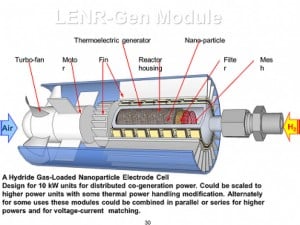New company LENUCO first reported here on Cold Fusion Now a year ago is now releasing more on its new LENR technology.
Designed by George H. Miley and his team, the LENR-Gen Module is conceived for 10 kw units, but can be scaled up for larger power needs.
VOTING has ended. No further info is to be found at this time…
Please Vote Now at Future Energy to give this project attention from ARPA-E.
Your vote will allow George Miley to speak at the ARPA-E Energy Innovation Summit Future Energy Pitching Session on February 25, 2013 6:30-8:30pm.
From the website:
Provide one sentence describing your core technology.
LENR Power Units use pressurized hydrogen –nickel nanoparticles undergoing low energy nuclear reactions to create a very high energy density heat source configured for co-generation power for home or industrial distributed power.
Short description of your technology
The recent discovery of practical applications of low energy nuclear reactions has created much activity and interest worldwide. Several companies, including LENUCO, have entered this business. Our approach using hydrogen loaded nanoparticles to produce heat that is converted to electrical output offers many advantages. Lenuco was founded to commercialize this technology and has a two-pronged business model. One prong is to manufacture small to medium range distributed power sources for home and industrial use. The second prong is to provide develop the technology for use by in Army bases, both homeland and in forward facilities, for a main power source. Both uses capitalize on the high power density and low maintenance, radiation free, long lifetime characteristics of LENR power cells.
What is the key element of your technology that differentiates it from existing solutions
LENUCO’s LENR power source is a revolutionary new technology based on high pressure hydrogen loading of nickel alloy based nanoparticles. Heat is produced by the resulting low energy nuclear reactions through a process which avoids any significant radioactivity. Uses range from home heating to central heating units. Compared to other renewable energy, LENR power units offer two distinct advantages: 24/7 operation and higher power density, hence significantly smaller units per unit power. LENR cells also provide power without greenhouse emissions and with no significant wastes. These advantages plus minimum maintenance and long lifetime result in a distinct economic advantage over other renewable energy sources as reflected by shorter pay-back times than solar, wind or fuel cells.
Related
George Miley: “Let’s find out what’s there” by Ruby Carat
Session 462 Advanced Concepts: LENR, Anti-matter, and Advanced Physics


This is some of the best information relative to LENR/COLD fusion that I have seen thus far. Especialy its potential as the total energy source for a HOME. And if I’m interpreting this information correctly, it is ready for commercialisation. Thank God,and George Miley!
I have been following the research on this potential form of energy source for as long as it has been possible on the internet. As you well know the news media, both, local and national won’t touch it — of course, we all know why.
I would like to communicate with George Miley, soon.
Please have a look at e-Cat Site the article “Belgian LANR Patents” the Belgian patent BE1002780 translated there into English ; the use in “cold fusion” of hydrogen (deuterium)
in plasma form between electrodes and change of polarity of the electrodes after absorption of deuterium in the cathode (see Fig. 3).
Please have a look at the possibility of nuclear fusion in liquid lithium using electroconductve metal particles containing deuterium or and/hydrogen in atomic form. The liquid lithium is at a high positive voltage as described on the e-Cat Site in the article “Cold Fusion by Coulomb explosion” (see the translated BE-patent). The nuclear fusion reaction between 7Li and a proton yields in aneutronic way helium (2He). A liquid lithium nuclear fusion reactor is known undr the name BLASCON (inventor Fraas US patent).